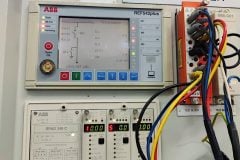Partial discharge measurement
Partial discharge measurement is an important method of assessing the quality of the insulation of power cable systems, particularly for extruded insulation materials. This article considers partial discharge from two points of view: the measurement of all partial discharges occurring within the cable system and the location of individual partial discharge sites.

Measurement of Partial Discharge
Perhaps the most significant factory test made on the insulation of full reels of extruded cable is the partial discharge test. This is usually done at power frequency, but can also be carried out at very low frequency and at some voltage significantly higher than normal working voltage to ground.
It would therefore seem logical to repeat tlus test on installed cables to detect any damage done during the shipping or laying or any problems created by jointing and terminating the cable. Unfortunately this is a difficult measurement to perform in the field due to the presence of partial discharge signals.
However, in spite of the difficulty, this test has been performed in the field where some special circumstances suggest it is worth the time and expense involved.
Typically this may be when damage or faulty installation is suspected or the cable route requires it to be of the highest possible reliability.

Once the necessary steps are taken to reduce the noise level below the partial discharge level to be measured, the test can provide a great deal of useful diagnostic data.
By observing the magnitude and phase of the partial discharge signals and how they vary with increasing and then decreasing test voltage, results will disclose information on the type and position of the defects and their probable effect on cable life.
Partial discharges can also be detected at system voltage with special sensors connected to the splice or termination, using the frequency spectrum of the discharges.
In summary, if the cable system can be tested in the field to show that its partial discharge level is comparable with that obtained in the factory tests on the cable and accessories, it is the most convincing evidence that the cable system is in excellent condition.
SOURCE: Electrical Power Cable Engineering











while performing high voltage DC test on power cables the negative polarity of source is connected to cable and postive is connected to ground ..why it is done so??
please explain.
Thank you
More than a comment I have a question to share with EEP and I’ll be very grateful if someone can help me with…
My question is. May a Hipot test be replaced by Partial Discharging Test? or Are them complementary?
Many Thanks in advance
Hi,
Actually, purpose of these two testing is different.
Partial discharge testing is used as predictive maintenance tool to determine on-line condition of medium voltage equipment and cables. it is not destrutive, and HIPOT can be.
HIPOT test is more suited to an acceptance test. DC hipot test can damage cable or equipment. PD diagnostic acceptance test is used the IEEE standards, while HIPOT is not.
Answer to your question: I think PD test does not eliminate need for HIPOT test, and yes, they are complementary in some applications, but not all.
BR